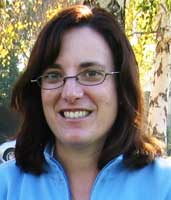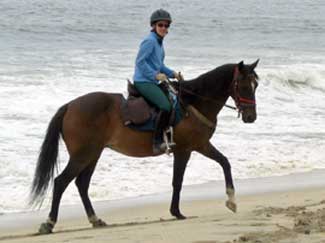By Gail Jacobs
 Not everyone is aware that the space between the stars isn't exactly empty. These vast interstellar tracts are filled with a fog of ice and dust particles that is scarcely perceptible. Understanding how this thin particle soup affects the formation of stars and their accompanying planets is the work of astrophysicist Dr. Jean Chiar.
Not everyone is aware that the space between the stars isn't exactly empty. These vast interstellar tracts are filled with a fog of ice and dust particles that is scarcely perceptible. Understanding how this thin particle soup affects the formation of stars and their accompanying planets is the work of astrophysicist Dr. Jean Chiar.
To study these small, dark particles, Dr. Chiar uses infrared telescopes both on the ground and in orbit (including NASA's Spitzer Space Telescope) to search for the absorption lines that are characteristic of ices, simple organic hydrocarbons, and silicates. While tiny ice-coated particles floating in space may seem like an esoteric field of study, Jean points out that it is exactly these small particles that can aggregate to form water-covered worlds such as Jupiter's moon Europa. The main ingredient of life - water - eventually comes from the cold mists that waft between the stars.
Very briefly, describe your research projects.
I use optical telescopes equipped with infrared detectors to study molecules in space. I look at very small submicron-size particles, 1/1000 the size of a grain of sand, located in the more diffuse regions of space where stars aren't forming. In these regions, these small mineral grains abound. They are made of materials similar to grains of sand on a beach - silicate minerals and carbon-bearing, or carbonaceous, dust particles. Deep within the denser colder regions, called "dark clouds," stars are forming or will eventually form. The thousand-fold increase in density and extremely cold conditions in the dark clouds encourage the formation of ice coatings, known as mantles, which form on the particles. Water-ice is the most abundant of the ice molecules. Since water is equated with life, that's when things really get interesting! Picture an M&M -- the chocolate is the mineral and the candy coating is the ice. The ratio of the ice is about right in terms of the thickness, so the mantle layers are very thin. Most of my research is based on targets outside our solar system but within our own galaxy.
Why should the general public care about your research?
My research involves learning about the building blocks, or origins, of everything! Our Earth, the Sun, the entire solar system, and even we humans are essentially made of this minute particle "stardust." The process of tracking and learning how the stars and planets come into being is extremely relevant not only to our understanding of our solar system and the entire universe, but to the advancement of science in general.
What tools do you use to study these ultra-small grains and determine their composition?
We use ground-based observatories located on high mountaintops and observatories in space as well as in air space, such as NASA's SOFIA (Stratospheric Observatory for Infrared Astronomy). The most recent space mission was NASA's Spitzer Space Telescope Mission. It's still in orbit but its cryogen has run out so it can no longer measure spectra, but can still take images with precision that would rival a 30-meter telescope on Earth.
Once we locate a diffuse or dark cloud region, we then choose stars beyond the region. The starlight gets absorbed by the particles in front if it, which is what we're really interested in. We point our telescope toward the region and take an absorption fingerprint or "spectrum." We then relay the data back to computers on Earth so we can examine and analyze the chemical fingerprints of the ice and mineral molecules.
What is the coolest thing about your project?
As our instrumentation gets more sensitive, we're able to see deeper into these obscured and distant regions. It's like seeing further back in time, which allows us to actually witness our Solar System's evolutionary process. For some time now, we've been able to observe stars that are much more massive that our Sun forming because they are fairly bright and illuminate everything around them. Today, we can actually see into regions forming Solar-mass stars and those not yet forming a star, allowing us to look further back into the genesis of the star formation process. Imagine being able to see the birth of a star!
What first sparked your interest in science?
Neither of my parents are scientists but my mom was particularly good about taking us to museums. Even when traveling, she would find the local science museums for us to visit. The hands-on museums were fairly new when I was a kid and I found them the most interesting. I always wanted to go back, even if the exhibits were the same.
In high school, I attended an all-girls school that didn't offer much science or math. After my second year, I switched to our public high school, which had physics and calculus. I took those courses in my junior year and really loved physics. I had an excellent teacher, and he's the one who got me thinking that I could do this forever.
What do you currently consider your biggest challenge?
I tend to be on the quiet side so I don't always voice my ideas to the external world. A second challenge is funding. My work relies 100% on grants. I need several grants funded annually to support my research and fund meeting attendance, equipment and so forth.
 How do you spend your time outside of work?
How do you spend your time outside of work?
My family members are all animal lovers. We have two horses; so much of my free time is spent with my daughter and the horses. I used to show my horse before my daughter was born. Now it's mostly trail riding. That's always been my first love outside of astronomy. We also have four cats that we've adopted from animal shelters. I didn't have pets growing up so I'm now making up for all that lost time.
I also teach astronomy at San Jose City College. I started an evening lab course for them in 2005, which has been very popular. I really enjoy it, but it can be extremely challenging. My classes are comprised of mostly low-income, minority adults who are working full time, so they are pretty tired when they come to class. The students have a lab-science requirement so they take astronomy lecture and lab, thinking astronomy involves looking at pretty pictures. But it does involve more than that.
What is your philosophy of life?
Work hard toward your goals, no matter what obstacles get in your way. Even if you think you can't do it, just be disciplined, put your mind to it, and then do your best.
What is your favorite movie and why?
I enjoyed the Spiderman movie series, starring Tobey Maguire, who, coincidentally, plays the jockey in the horseracing movie, Seabiscuit. Both are stories that involve unlikely heroes. I resonate with the great quote in the first Spiderman movie, in which Spiderman's uncle said, "With great power comes great responsibility." I think that can be applied to anyone. Each of us is in a position to help others less fortunate, and I like that aspect of the movie.
If you could have a month to do whatever you wanted, what would you do?
I'd like to go to a training barn where I could learn more about horses and work with young horses. I'd love the area to be in a remote area where I could ride the horses during the day and then sit out under the dark sky.
Learn more about Jean and her interesting research in her full interview.